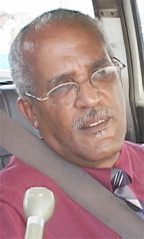The Link Show is “without doubt, Guy-ana’s leading satirical review,” to quote Ron Robinson’s Programme Notes for Link Show 26. Even though they do say so themselves, The Link is way ahead of the competition. Impartial evidence will support that, and after the resounding success of Link Show 25 in 2009, the annual revue has returned in 2010 to continue the tradition it has established.

It is a standard as well as a tradition, since The Link Show is one of the very few extant annual satirical revues in the Caribbean that is keeping this theatrical type alive. It has come to be the most popular theatrical event in Guyana and occupies a fixed place on the annual calendar as a truly national event. I say “a fixed place” even though it has floundered not only in quality, but in regularity, missed a few years and threatened to disappear. It was rescued in 2009 with the re-unification of the Gem Madhoo-Nascimento/Ron Robinson team when GEMS Theatre Productions joined with The Theatre Company to produce the show which had not been seen for a few years. Indeed, it is no longer a secret that it is unlikely that Robinson, the country’s most established director, can produce the annual show without Madhoo-Nascimento, the country’s most accomplished producer/manager.

Having reasserted the tradition, The Link faced a challenge from a few pretenders who had been producing similar types of theatre, but it shook that off comfortably. The others did not manage to match the production strength, the worthiness of the scripts or the understanding of the genre. In Guyana, it seems, ‘satire’ is another name for ‘comic performance.’ When one writes something that is merely humorous, one thinks one has written satire, but although satirical theatre is often comic, comic theatre alone is not satire. In these other productions, sometimes the quality of the piece is so weak it fails to be funny.
Satire is made of sterner stuff. Robinson understands what it is supposed to be. He writes in the Programme Notes that “[we have] always been conscious of the nature of the production of satire. We have always endeavoured to ensure the content is, as far as is humanly possible, not merely to evoke laughter (though this is important) but to be a lampooning mirror of our society and, as such, the catalyst for change.” The other rival outfits (the ‘pretenders’) consistently fall down in this area, and very often in previous years, so did The Link itself. Although both last year and this year it got the formula right, Robinson ends his Notes with “So enjoy Link Show 26 laugh, even if it’s at yourself.” He forgot to urge his audience to seek to change; to abandon those ills and follies that the laughter is supposed to isolate and ridicule. He does not point out to them, lest they forget as they are wont to do, that that is the purpose of having them laugh at themselves.
Interestingly, it was laughter that was one of the strong points of Link Show 26. One of the high points was that it was exceedingly strong on entertainment. There was much to laugh at, including the lampoon, but it was not only the hilarity of the subject, but the manner in which things were done. The emphasis, or rather the achievement, was more in the area of entertainment than incisive social comment, even though there was much of that. Most of the pieces were genuinely funny, most punch-lines were sharp and often witty, and none of the skits were drawn out unnecessarily. Robinson has managed to settle down to a style that is suitable and effective to lampoon, take-off and the variation of farces, including a few instances of high farce. It is a style also that the actors understand and some of the more experienced have come to master.

While satirical performance demands a good deal of intellectual work, and the right kinds of performance styles, one cannot avoid a bit of slapstick. In fact, slapstick humour has become much more prevalent in Caribbean theatre to the point where there is a thriving industry with a demand for such plays of the ‘roots theatre’ variety. So, Link Show 26 got in on the act. There was a good deal of low farce and camp to go with those skits of a different quality which increased the hilarity and the entertainment value.
Both of these in this production were, however, also enhanced by other strengths of the production. It achieved a level of sophistication whereby it could present successful skits, social commentary and humour without words. A few pieces made satirical points without dialogue, and with fairly innovative non-verbal techniques.
Another feature that heightened the efficiency of the production, and so the entertaining outcomes, was the fact that the production was ‘staged’ in the sense of being neatly and presentably choreographed, and the actors were able to perform ‘movement.’ This added quality was no doubt owed to the work of dancer/actor Kijana Lewis. A few of the pieces were treated in this way, thus contributing to the overall tightness of the show’s choreography. This tightness was not only a tautness in technique and performance, but also the closeness of the dances and other choreographed movement to the business of satire. Some of them were used, not just to exploit the variety that dance can lend, but to have dance as a performance strategy and a means of satirical communication.
Yet another positive feature was the way the ‘quickies’ had generally improved. Where they were previously put in as gap-fillers and to allow scene changes, they were now significant satirical items. At one time they were mere jokes, funny interludes related to nothing, but now they combined this with commentary, so that most of them were condensed, brief social comments or lampoon. Worthy of note as well, was that the non-verbal innovation was used in some of the ‘quickies.’
There was further creditable innovation in a few major items too, such as the take-off on the Guyanese folk songs. Here was the use of some high farce in a mock analysis of the dubious qualities of this form of national heritage. It was very good burlesque. The songs were illustrated by actors who only appeared in silhouette, and the total performance was complete in the way they acted in the precise style of the high farce. All else fell into place – language, tone and pace. The blemish in the presentation was that the words of the songs were not all clear and were sometimes drowned by the instruments, and one had to depend on one’s own knowledge of the words. This, however, was a class item.
Two others of similar note were Over the Fence and Uncle Rufus. These stood out for their content and performance rather than for their innovation, since they were old regular Link Show features. After good content well presented, they still managed to end with telling punch-lines. Of further interest was the way they complemented each other in their parallels and variation, since one was a dialogue and a verbal pas de deux while the other was a dramatic monologue.
The overall presentation of the show was of exemplary quality and this added further to the entertainment value. It was credit to Robinson as a seasoned, efficient director. There was general smoothness and fluency which were important because of the driving pace of the performance, leaving a feeling that stage management must have been in order. It was well-paced, crisp and fast-moving, which helped because it was a lengthy show – unnecessarily so at a playing time of well over three hours.
Link Show 26 also took on the significant characteristic of take-off, lampoon and commenting on itself. The Link itself came in for some serious picong. This touched persons who were members of the cast and team as well as the very show that was rampantly ridiculing others. In some cases it was courageous, where Henry Rodney was able to take picong aimed at his recent personal disaster involving loss by fire. In other cases they ‘talk truth’ in the reference to the fact that the revival of the Link came about because Madhoo-Nascimento stepped in to help get it back on stage. One of the skits said “Ron can’t do it without Gem.”
Yet this self-satire very often converted into self-praise. The show repeatedly praised itself, particularly in the many self-congratulatory references and anecdotes in ‘Scriptwriters meeting.’ One often wondered whether they were fictionalizing the writing of Link Show scripts, the writing of their own history or of praise songs to themselves. This burlesque mock-meeting was, however, another of the strengths of the show, finding yet another frame for laughter and commentary.
And moreover, if they sang their own praises, they were only joining a chorus made up of the large audiences which have been thoroughly entertained to the point where they just will not let the show go. The Link deserved the praise. The audience response has made it a firm tradition and has deemed it the best revue in Guyana and among the strong significant survivals of this theatrical type in the Caribbean. Whether these laughs at themselves will result in sublime change in the audience is quite another issue.
